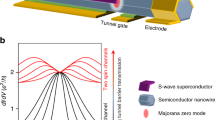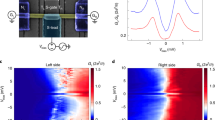Abstract
Majorana modes are zero-energy excitations of a topological superconductor that exhibit non-Abelian statistics1,2,3. Following proposals for their detection in a semiconductor nanowire coupled to an s-wave superconductor4,5, several tunnelling experiments reported characteristic Majorana signatures6,7,8,9,10,11. Reducing disorder has been a prime challenge for these experiments because disorder can mimic the zero-energy signatures of Majoranas12,13,14,15,16, and renders the topological properties inaccessible17,18,19,20. Here, we show characteristic Majorana signatures in InSb nanowire devices exhibiting clear ballistic transport properties. Application of a magnetic field and spatial control of carrier density using local gates generates a zero bias peak that is rigid over a large region in the parameter space of chemical potential, Zeeman energy and tunnel barrier potential. The reduction of disorder allows us to resolve separate regions in the parameter space with and without a zero bias peak, indicating topologically distinct phases. These observations are consistent with the Majorana theory in a ballistic system21, and exclude the known alternative explanations that invoke disorder12,13,14,15,16 or a nonuniform chemical potential22,23.
This is a preview of subscription content, access via your institution
Access options
Access Nature and 54 other Nature Portfolio journals
Get Nature+, our best-value online-access subscription
$29.99 / 30 days
cancel any time
Subscribe to this journal
Receive 12 print issues and online access
$259.00 per year
only $21.58 per issue
Buy this article
- Purchase on Springer Link
- Instant access to full article PDF
Prices may be subject to local taxes which are calculated during checkout




Similar content being viewed by others
Change history
11 March 2024
A Correction to this paper has been published: https://doi.org/10.1038/s41565-024-01602-8
References
Read, N. & Green, D. Paired states of fermions in two dimensions with breaking of parity and time-reversal symmetries and the fractional quantum Hall effect. Phys. Rev. B 61, 10267 (2000).
Kitaev, A. Y. Unpaired Majorana fermions in quantum wires. Phys. Usp. 44, 131–136 (2001).
Fu, L. & Kane, C. L. Superconducting proximity effect and Majorana fermions at the surface of a topological insulator. Phys. Rev. Lett. 100, 096407 (2008).
Lutchyn, R. M., Sau, J. D. & Das Sarma, S. Majorana fermions and a topological phase transition in semiconductor-superconductor heterostructures. Phys. Rev. Lett. 105, 077001 (2010).
Oreg, Y., Refael, G. & von Oppen, F. Helical liquids and Majorana bound states in quantum wires. Phys. Rev. Lett. 105, 177002 (2010).
Mourik, V. et al. Signatures of Majorana fermions in hybrid superconductor-semiconductor nanowire devices. Science 336, 1003–1007 (2012).
Das, A. et al. Zero-bias peaks and splitting in an Al-InAs nanowire topological superconductor as a signature of Majorana fermions. Nat. Phys. 8, 887–895 (2012).
Deng, M. T. et al. Anomalous zero-bias conductance peak in a Nb–InSb nanowire–Nb hybrid device. Nano Lett. 12, 6414–6419 (2012).
Albrecht, S. M. et al. Exponential protection of zero modes in Majorana islands. Nature 531, 206–209 (2016).
Deng, M. T. et al. Majorana bound state in a coupled quantum-dot hybrid-nanowire system. Science 354, 1557–1562 (2016).
Chen, J. et al. Experimental phase diagram of zero-bias conductance peaks in superconductor/semiconductor nanowire devices. Sci. Adv. 3, e1701476 (2017).
Liu, J., Potter, A. C., Law, K. T. & Lee, P. A. Zero-bias peaks in the tunneling conductance of spin-orbit-coupled superconducting wires with and without Majorana end-states. Phys. Rev. Lett. 109, 267002 (2012).
Bagrets, D. & Altland, A. Class D spectral peak in Majorana quantum wires. Phys. Rev. Lett. 109, 227005 (2012).
Pikulin, D. I., Dahlhaus, J. P., Wimmer, M., Schomerus, H. & Beenakker, C. W. J. A zero-voltage conductance peak from weak antilocalization in a Majorana nanowire. New J. Phys. 14, 125011 (2012).
Lee, E. J. H. et al. Zero-bias anomaly in a nanowire quantum dot coupled to superconductors. Phys. Rev. Lett. 109, 186802 (2012).
Lee, E. J. H. et al. Spin-resolved Andreev levels and parity crossings in hybrid superconductor-semiconductor nanostructures. Nat. Nanotech. 9, 79–84 (2014).
Takei, S., Fregoso, B. M., Hui, H.-Y., Lobos, A. M. & Das Sarma, S. Soft superconducting gap in semiconductor Majorana nanowires. Phys. Rev. Lett. 110, 186803 (2013).
Chang, W. et al. Hard gap in epitaxial semiconductor–superconductor nanowires. Nat. Nanotech. 10, 232–236 (2015).
Gül, Ö. et al. Hard superconducting gap in InSb nanowires. Nano Lett. 17, 2690–2696 (2017).
Zhang, H. et al. Ballistic superconductivity in semiconductor nanowires. Nat. Commun. 8, 16025 (2017).
Liu, C.-X., Sau, J. D. & Das Sarma, S. Role of dissipation in realistic Majorana nanowires. Phys. Rev. B 95, 054502 (2017).
Liu, C.-X., Sau, J. D., Stanescu, T. D. & Das Sarma, S. Andreev bound states versus Majorana bound states in quantum dot-nanowire-superconductor hybrid structures: trivial versus topological zero-bias conductance peaks. Phys. Rev. B 96, 075161 (2017).
Prada, E., San-Jose, P. & Aguado, R. Transport spectroscopy of NS nanowire junctions with Majorana fermions. Phys. Rev. B 86, 180503(R) (2012).
Gazibegovic, S. et al. Epitaxy of advanced nanowire quantum devices. Nature 548, 434–438 (2017).
Kammhuber, J. et al. Conductance quantization at zero magnetic field in InSb nanowires. Nano. Lett. 16, 3482–3486 (2016).
Kammhuber, J. et al. Conductance through a helical state in an indium antimonide nanowire. Nat. Commun. 8, 478 (2017).
Cole, W. S., Sau, J. D. & Das Sarma, S. Proximity effect and Majorana bound states in clean semiconductor nanowires coupled to disordered superconductors. Phys. Rev. B 94, 150505(R) (2017).
Stanescu, T. D. & Das Sarma, S. Proximity-induced low-energy renormalization in hybrid semiconductor-superconductor Majorana structures. Phys. Rev. B 96, 014510 (2017).
Zhang, H. et al. Quantized Majorana conductance. Preprint at https://arxiv.org/abs/1710.10701 (2017).
Osca, J., Ruiz, D. & Serra, L. Effects of tilting the magnetic field in one-dimensional Majorana nanowires. Phys. Rev. B 89, 245405 (2014).
Rex, S. & Sudbø, A. Tilting of the magnetic field in Majorana nanowires: critical angle and zero-energy differential conductance. Phys. Rev. B 90, 115429 (2014).
Nijholt, B. & Akhmerov, A. R. Orbital effect of magnetic field on the Majorana phase diagram. Phys. Rev. B 93, 235434 (2016).
Mishmash, R. V., Aasen, D., Higginbotham, A. P. & Alicea, J. Approaching a topological phase transition in Majorana nanowires. Phys. Rev. B 93, 245404 (2016).
Vuik, A., Eeltink, D., Akhmerov, A. R. & Wimmer, M. Effects of the electrostatic environment on the Majorana nanowire devices. New J. Phys. 18, 033013 (2016).
Car, D., Wang, J., Verheijen, M. A., Bakkers, E. P. A. M. & Plissard, S. R. Rationally designed single-crystalline nanowire networks. Adv. Mater. 26, 4875–4879 (2014).
Flöhr, K. et al. Manipulating InAs nanowires with submicrometer precision. Rev. Sci. Instrum. 82, 113705 (2011).
Suyatin, D. B., Thelander, C., Björk, M. T., Maximov, I. & Samuelson, L. Sulfur passivation for ohmic contact formation to InAs nanowires. Nanotechnology 18, 105307 (2007).
Gül, Ö. et al. Ballistic Majorana nanowire devices. 4TU.ResearchData. https://doi.org/10.4121/uuid:b3f993a7-1b8b-4fd8-8142-5fa577027cdd (2017).
Acknowledgements
We thank A. R. Akhmerov, O. W. B. Benningshof, M. C. Cassidy, S. Goswami, J. Kammhuber, V. Mourik, M. Quintero-Pérez, J. Shen, M. Wimmer, D. J. van Woerkom and K. Zuo for discussions and assistance. This work has been supported by the Netherlands Organisation for Scientific Research (NWO), European Research Council (ERC) and Microsoft Corporation Station Q.
Author information
Authors and Affiliations
Contributions
Ö.G., H.Z. and J.D.S.B fabricated the devices, performed the measurements, and analysed the data. M.W.A.d.M. contributed to the device fabrication. D.C., S.P. and E.P.A.M.B. grew the InSb nanowires. A.G. contributed to the experiments. K.W. and T.T. synthesized the hBN crystals. L.P.K. supervised the project. Ö.G., H.Z. and J.D.S.B. co-wrote the paper. All authors commented on the manuscript.
Corresponding authors
Ethics declarations
Competing interests
The authors declare no competing financial interests.
Additional information
Publisher’s note: Springer Nature remains neutral with regard to jurisdictional claims in published maps and institutional affiliations.
Supplementary information
Supplementary Information
Supplementary Figs. 1–7, Supplementary Text
Rights and permissions
About this article
Cite this article
Gül, Ö., Zhang, H., Bommer, J.D.S. et al. Ballistic Majorana nanowire devices. Nature Nanotech 13, 192–197 (2018). https://doi.org/10.1038/s41565-017-0032-8
Received:
Accepted:
Published:
Issue Date:
DOI: https://doi.org/10.1038/s41565-017-0032-8
This article is cited by
-
Hosohedral nodal-line superconductivity in hexagonal ABC Dirac semimetals
Communications Physics (2024)
-
Superconducting tunnel junctions with layered superconductors
Quantum Frontiers (2024)
-
Spin-polarized Majorana zero modes in proximitized superconducting penta-silicene nanoribbons
Scientific Reports (2023)
-
Recent progress on Majorana in semiconductor-superconductor heterostructures—engineering and detection
Science China Physics, Mechanics & Astronomy (2023)
-
Anomalous universal conductance as a hallmark of non-locality in a Majorana-hosted superconducting island
Nature Communications (2022)



